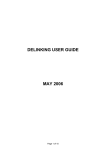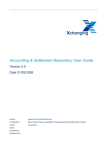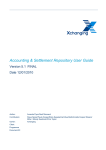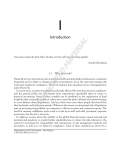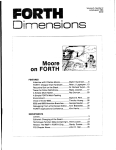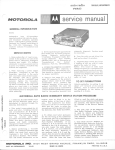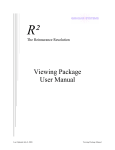Download DELINKING USER GUIDE March 2010
Transcript
DELINKING USER GUIDE March 2010 Delinking User Guide – March 2010 Document History Revision date August 2002 April 2004 July 2007 August 2008 March 2010 Summary of Changes Review of procedures by LMP Programme Office Contact details updated General update based on feedback received Premium Payment Improvements Working Group Report changes Change in default from ‘grouping’ to ‘ungrouping’ Table of contents 1. Introduction P3 2. Contract certainty P3 3. Benefits of delinking P3 4. Scope of delinking P4 5. Process explanation P5 6. Releasing premiums into settlement P6 7. Broker delinking trigger screens P7 8. Insurer delinking screens (companies) P13 9. Lloyd’s enquiry systems P17 10. Special processing arrangements P19 11. Signing Information and messages P23 12. Testing P24 13. Contact information P24 Appendix A – Delinking stamp P25 Appendix B – Release / settlement timetable P26 Appendix C – Delinked signing file content P27 [Note – Wherever the word ‘Insurers’ is included in this document it should be deemed to refer to insurers or reinsurers.] Page 2 of 27 Delinking User Guide – March 2010 1 Introduction Delinking was introduced in October 1999 as one of the International Process Compliance (IPC) initiatives. Delinking separates the submission of premium closing information to Xchanging from the instruction to settle the transaction. The London market reform programme, initiated in 2000, championed delinking as a means of speeding-up both premium payment and the issuance of contract documentation to the client. Delinking has been further endorsed by the market reform programme for its contribution towards achieving contract certainty. This User Guide provides brokers with details of procedures that should be adopted when submitting delinked entries to Xchanging and provides insurers with details of how they can take advantage of the earlier availability of signed line and accounting data. The Guide should be read in conjunction with the other delinking and contract certainty documentation which is available for download from the market reform website www.londonmarketgroup.co.uk 2 Contract certainty A key requirement of the contract certainty reform programme is that insurers receive confirmation of their signed line promptly. Use of delinking enables brokers to meet this requirement – i.e. by submitting delinked premium entries to Xchanging at an early stage and by the subsequent earlier distribution of signed line information to insurers via the insurer signing messages (and e-mailed reports). 3 Benefits of delinking Non-delinked entries are settled three working days1 after they have been processed by Xchanging. This means that brokers normally wait until they have received premium funds from the client before they submit the documentation to Xchanging. Xchanging aims to process all electronic premium entries in an average of 3 working days but, in the event of there being queries raised on the transaction, processing and hence settlement of the premium can be further delayed. Use of delinking can eliminate these delays. Submitting premium entries to Xchanging on a delinked basis can provide both brokers and insurers with the following benefits: • Insurers can be provided with details of their signed lines and accounting information at an early stage (within the contract certainty target of 30 days after inception of the contract). • Queries can be resolved at an early stage meaning that settlement of premium monies is not delayed. • Brokers can control when the entries are released into settlement thus enabling earlier payment of premium to insurers. • Client / insurer settlement can be synchronised. • Brokers receive fewer requests for information from insurers. • Signed policies and wordings can be issued to clients at an earlier stage in the process. • Improved credit control. • An on-line enquiry system is available that provides brokers and company market insurers with a summary of premiums waiting to be settled. Lloyd’s insurers can review details of de-linked signings via the Lloyd’s Account Enquiry system (refer to section 9). __________________________________ 1 Companies in run-off can opt to settle their business on a weekly, monthly or direct settlement basis. Page 3 of 27 Delinking User Guide – March 2010 4 Scope of delinking 4.1 Mandatory usage The London Market Group (LMG) has agreed that delinking should be used for all original and additional premiums for direct insurance, facultative reinsurance and excess of loss reinsurance, unless they are specified as either optional or out of scope in this document. However there are some extenuating circumstances where delinking may not be used. Examples include: • Prompt payment warranties, where delinking could mean the due date is missed. • Premium payment warranties where the 20 day target for the submission of the delinked account was missed and the use of delinking would result in a warranty breach. • Transactions with terms of trade less than 30 days. • A late placement where the date the last line is written is too close to the SDD to allow the premium to be delinked and then released on time. • Where the premium has already been paid to the broker prior to the submission of the delinked account. 4.2 Optional usage Use of delinking is optional for the following transactions: Binding authority bordereaux & bulking lineslips - Using delinking on these transactions may delay settlement to insurers rather than speed it up. Once a delinked account has been processed the broker would need to wait until the multiple premiums which form the transaction have been paid before the transaction could be released into settlement. The alternative approach is to process such premiums on a pay as paid basis as a cash transaction. Return premiums –Delinking a return premium will also delay the return of funds to the insured. However some brokers may choose to delink these transactions so they have a common approach to all premium transactions. 4.3 Out of scope The following transaction types are currently outside the scope of delinking: • Proportional Treaty Statements – Xchanging system constraints currently prevent proportional treaty accounts from being processed on a delinked basis. • Nil Premium Entries – Entries that do not involve the actual settlement of premium monies via Xchanging do not need to be submitted as delinked transactions. Examples include FDO signings, nil premium adjustments and ‘paid by cheque’ items. • Transactions Requiring Simultaneous Settlement – Both insurers and brokers sometimes require additional premiums to be settled simultaneously with claims or return premiums. Although this situation arises fairly frequently on business placed via binding authorities and bulking line-slips, simultaneous settlement is not limited to these types of contract and can be requested on any type of business. These entries should not be submitted on a delinked basis as Xchanging is instructed to ensure that the additional premiums are released into settlement at the same time as the claim or return premium entry in these circumstances. Page 4 of 27 Delinking User Guide – March 2010 • Reinstatement Premiums – Reinstatement premiums on excess of loss reinsurance contracts should not be delinked. This includes entries which do not require simultaneous settlement with claims (as the claim entry will have already been settled in these circumstances and the additional premium should, therefore, be paid immediately). • Lloyd's Premium Reserve Accounts – Lloyd’s premium entries which include reserve premiums cannot be delinked. This is due to the non-standard processing procedures that have to be followed on this type of transaction. (In the event of brokers submitting any of the above-mentioned transaction types as delinked entries, Xchanging will process these submissions on a non-delinked basis.) 5 Process explanation 5.1 The submission of delinked entries Once the broker has placed the risk and signed-down the market, the London Premium Advice Note(s) (LPAN(s)) and other closing documentation should be submitted to Xchanging. It is important for brokers to submit documentation to Xchanging as soon as possible. The Premium Payment Improvements Working Group (PPIWG) report recommends that the delinked account should be submitted to Xchanging within 20 days of inception, or in the case of late placements, 20 days after placing is complete. This will allow Xchanging to perform the necessary accounting checks, deal with any queries and process the transactions well before the items are due to be released into settlement (i.e. on or before the SDD). Brokers should note that if they submit delinked entries close to the SDD then subsequent processing queries may lead to the entries being categorised as being ‘late payments’. Each transaction must be clearly marked as ‘IPC Delinked’. This must be clearly legible on each LPAN. If the documentation is not clearly marked as "IPC Delinked" the transaction will be treated as a cash signing and will be included in the next settlement run. An example ‘IPC Delinked’ stamp can be found in Appendix A of this document. For transactions received by Xchanging on or after 1st April 2010, brokers must ensure that where grouped settlement is required by either insurers or the broker, the affected LPAN’s are clearly marked with the word ‘GROUPED’. (further details of all procedures are provided within section 10.2). Although many brokers refer to the submission of delinked accounts within the Subscription Agreement section of their Market Reform Contract (MRC), it is not necessary for delinking to be specifically mentioned within the MRC in order to allow brokers to submit closings on a delinked basis. 5.2 Processing at Xchanging Xchanging will check and process the closing and will flag the item as being delinked. Any technical accounting queries will be resolved at this stage, thus ensuring that there is no delay to the settlement of the premium. Xchanging will process the delinked transaction but will withhold the item from settlement. A bureau signing number and date will be allocated to the transaction at this stage. If the premium has been submitted on paper then the signing number and date will be transcribed onto the paper MRC (or, in the case of additional and return premium entries, on the Market Reform Contract Endorsement (MRCE) and returned to the broker. Paper MRC/MRCE will also be marked with the word ‘Delinked’. For transactions submitted to Xchanging electronically via the Insurers’ Market Repository (IMR) the signing number and date will be added to Page 5 of 27 Delinking User Guide – March 2010 the IMR and also advised via the signing messages (Refer to section 11 for more details) Details of both Lloyd’s and company market delinked premium signings are added to a suspense database known as the Interactive Settlement System (i.e. rather than being submitted to the main signing and settlement systems). Settlement of these premium signings will not occur until this is triggered by the broker. 5.3 Signing number and date allocation Signing numbers and dates are allocated to delinked premium entries when they are processed and added to the suspense database. It is important to note that the allocation of a signing number and date at this stage does not denote that any monies will be settled. (Details of signing information that is provided to insurers and brokers within the daily signing messages can be found in section 11.) 5.4 Additional premiums Additional premiums can be submitted and processed as delinked entries before the original premium has been released into settlement. However, it is not possible to release a delinked AP into settlement before the original premium has been settled. 6 Releasing premiums into settlement Brokers can release items into settlement as soon as their client has paid the premium. Both Lloyd's and company market items are stored together on the ‘suspense’ database that is mentioned above. At the end of each working day all items that have been released for settlement are removed from the suspense file and are processed through central accounting in the usual manner. A more detailed explanation of this process can be found in Appendix B. There are three options available to brokers as to how entries can be released into settlement and details of these options are provided below. 6.1 Interactive trigger Brokers can utilise an on-line interactive function to release premiums into settlement. This function, named ‘IPC RELEASE FOR SETTLEMENT’, can be accessed via the ‘BUREAU GENERAL FACILITIES’ menu within the LPC mainframe enquiry system. Brokers can release both Lloyd’s and company market entries into settlement via this system. Details of the screens can be found within section 7 of this document. Access to the function is controlled by Xchanging’s standard on-line security system. Two levels of access are available: • Enquiry Only – The IPC ITEMS AWAITING SETTLEMENT enquiry function must be given to all users who need access for enquiry or for update/release. • Enquiry and Update/Release - The IPC UPDATE/RELEASE function must additionally be given to any users who need to be able to update and release transactions into settlement. Users need to ask their Security Administrator to add the function to their user profile. (Brokers who cannot access the LPC enquiry systems should contact the Xchanging Service Centre – tel: 0870 380 0830 or email: [email protected]) Page 6 of 27 Delinking User Guide – March 2010 6.2 RESETT message As an alternative to the interactive trigger, brokers can use the RESETT EDI message to release delinked entries. RESETT is the globally recognised ACORD standard message for financial account data and allows brokers to automate the release of items into settlement. Copies of the RESETT specification can be obtained from the ACORD website www.acord.org. 6.3 Release by Xchanging As an alternative to using the interactive system or the RESETT message, brokers can contact Xchanging to request that items are released into settlement. Brokers may need to use this option because: • they do not currently have access to the interactive system; • the transaction is subject to a premium warranty which has been breached (refer to section 10.3); • the rate of exchange that has been applied is outside of the tolerance allowed within the delinking system (refer to section 7.2). • a premium payment warranty has been applied which has a different effective date to the Settlement Due Date. (Details of how to manage this particular scenario may be found in section 10.3) In these instances, the broker should initially contact Enquire (tel. 01634 887899 or email [email protected]) who will contact the appropriate team leader at Xchanging to make them aware that they would like an item to be released into settlement. Confirmation of this request and details of the signing number for the premium entry involved should then be e-mailed (or faxed) to Enquire. Details of such requests should be submitted to Xchanging before 1pm on the day when release is required. Where a premium warranty has been breached, Xchanging will require evidence of the insurer(s)’ agreement to an extension of the warranty period. Where a rate of exchange is outside of the tolerance referred to above, the broker will need to provide evidence as to why the rate of exchange that they have used should apply. 7 Broker delinking trigger screens 7.1 Release for settlement As mentioned above, brokers need to access the ‘IPC RELEASE FOR SETTLEMENT’ function. Users will then be presented with an options screen that allows them to enter their chosen selection and sort criteria. A list of items matching the selection criteria entered will then be presented in the specified sequence. When all selections have been made, each item will be presented in turn. For each item additional screens will be displayed showing further details of the transaction. If the user has been given update authority then it will be possible to update some of the data (such as the exchange rate) and to release the item into settlement. Alternatively, an effective date can be applied to the release. This will have the effect of releasing the premium into settlement on a specified future date (rather than settling the entry three working days after the release date). A final screen is optionally available, to show the amounts and due dates of any deferred instalments. (These details cannot be amended by the broker.) Page 7 of 27 Delinking User Guide – March 2010 7.2 Convertible currency entries For convertible currency transactions the broker is required to enter a nominal rate of exchange on their LPAN's at the delinked stage. This can be updated by the broker to show the true rate of exchange when they release the entry into settlement. The system will validate the exchange rate used by the broker against the rate that is held by Xchanging on their exchange rate tables. The rates of exchange held on this table are updated on a weekly basis. When validating the exchange rate that the broker has used, the system applies a 10% tolerance against the rate of exchange that is held on the table. If the broker wishes to enter an exchange rate outside of that tolerance it will be necessary to contact Xchanging to execute the release (refer to section 13). 7.3 Screen 1 – release for settlement 7.3.1 Filter options This screen allows brokers to specify selection criteria for the transactions they wish to view and sort options to determine the order in which they are to be presented. • The broker number must be entered. This will be pre-set by the system, but can be changed if the broker’s organisation operates more than one broker number. • Users must indicate the market(s) for which they want to see transactions. Enter a ‘Y’ next to any or all of the bureau identifiers shown (LIRMA, ILU and/or Lloyd’s). • An optional settlement currency code can be entered to restrict the search. If nothing is entered in this field all settlement currencies will be included. • A broker contact name can be entered to limit the search to those entries where that name was recorded on the LPAN. This is optional. • Released signings. If ‘N’ is entered then only transactions not yet marked for release will be selected. If ‘Y’ is entered then only items already marked for release, but still on the suspense file, will be selected. If nothing is entered then all transactions will be selected. 7.3.2 Sort options Users should enter ‘Y’ in one of the options to determine the order in which they want the selected transactions to be listed. The sequence options are Settlement Due Date, Broker Reference 1, Broker Reference 2 or Unique Market Reference. Page 8 of 27 Delinking User Guide – March 2010 Page 9 of 27 Delinking User Guide – March 2010 7.4 Screen 2 – list items pending This screen lists the items selected by the broker. The screen is scrollable left/right and up/down, using F keys as shown. Any number of items may be selected from this screen at one time. To do this the user should enter an ‘S’ into the ‘select field’ on the left side of the screen next to the item. To de-select an item that was chosen in error, enter a space into the select field. Not all items will have a select field appearing next to them. Where items have been grouped by Xchanging (e.g. where multiple premiums must be paid at the same time) only the first item in the group will be able to be selected. Selection of that item will cause all of the other items in the group to be automatically selected by the system at the same time. When all selections have been made, the user can press F5 to display further details of the transactions selected. (Refer to section 10.2 for further information on grouping.) Page 10 of 27 Delinking User Guide – March 2010 7.5 Screen 3 – transaction details This screen displays details of a selected transaction. If a number of transactions have been selected – either by the user or by the system for grouped items – each transaction will be presented in turn. For users who only have enquiry authority, all data will be protected. For users with update and release authority, the following fields can be amended: • Broker contact name and telephone number; • Broker reference 1 and 2; • Rate of exchange (for convertible currency items only); • Net premium for settlement (for convertible currency items only); • The release indicator; • The effective date for the release. To release an item into settlement, enter ‘Y’ in the ‘Release for Settlement’ field. Optionally an effective date can also be entered. Items marked for release will remain on the suspense database until the end of the current day (7pm), or the end of the effective date (if entered). Up to that time it is possible to de-activate any items marked for release by entering ‘N’ in the release field. In some circumstances the system may prevent the release of an item – e.g. if a premium warranty is in effect and the warranty date has expired. An error message will be displayed to explain the reason for not allowing the release. In these cases it will be necessary to contact Enquire (tel. 01634 887899 or e-mail [email protected]) before 1pm on the day when release is required to execute the release (refer to section 6.3). Page 11 of 27 Delinking User Guide – March 2010 7.6 Screen 4 – instalment details This screen lists any deferred premium instalments for the transaction. The screen, which is selected by pressing F5 on the Transaction Details screen, will only be displayed if deferred instalments are present. If the rate of exchange has been updated for a convertible currency transaction, Xchanging will automatically re-calculate the net instalment amounts. The broker cannot update this screen. Page 12 of 27 Delinking User Guide – March 2010 8 Insurer delinking enquiry screens (companies) 8.1 Company insurer enquiry function Company market delinked entries do not appear on the LPC signings history enquiry system until they have been released into settlement. A separate enquiry function is provided for companies, allowing users to view delinked signings for which they are onrisk and that are present on the suspense database awaiting settlement. The IPC DELINKED COMPANY ENQUIRY system can be found as an option on the GENERAL ENQUIRIES menu. The following screens will be displayed. 8.2 Screen 1 – IPC delinked entries awaiting settlement This screen allows users to enter selection criteria and sort options for the enquiry. The sort options allow the results to be displayed according to Settlement Due Date or Signing Date (i.e. the date the items were added onto the suspense database). Page 13 of 27 Delinking User Guide – March 2010 8.3 Screen 2 – List of items pending This screen displays all the items selected by the user. The screen is scrollable left/right and up/down using F keys as shown. To select an item from the list, enter an “S” in the field next to the record on the list screen and press <ENTER>. 8.4 Screen 3 - transaction details This screen displays the detail of the selected transaction. Page 14 of 27 Delinking User Guide – March 2010 8.5 Screen 4 – instalment details This screen lists any deferred instalments for the transaction. The screen, which is selected by pressing F5, will only be displayed if deferred instalments are present. Page 15 of 27 Delinking User Guide – March 2010 8.6 Cancelled signings Any signings which have been cancelled can be viewed using the F14 Key (shift key + F2). Cancelled and cancellation signings will be displayed on the ‘List of Items Pending’ screen for one week after the date of the cancellation entry. They will then be displayed on the cancelled signings screen in the order of the selections. When viewed the reason for cancellation will also be displayed. This screen can also be viewed via the LPC Enquiry facility. Page 16 of 27 Delinking User Guide – March 2010 8.7 Policy status This screen, which can be accessed by pressing F9 on the Transaction Details screen, provides details of policies that have been signed for delinked entries. 9 Lloyd's enquiry system facilities Managing agents and brokers can review details of delinked Lloyd’s premium entries by accessing the Account Enquiry system. The enquiry system highlights whether the entry has been processed but not yet settled or whether it has been released into settlement (‘linked’). Customers who cannot access this system should contact Xchanging Service Centre – tel. 0870 380 0830 or email: [email protected].. Page 17 of 27 Delinking User Guide – March 2010 9.1 History screen Signing information can be viewed within the Slip History screen within the Lloyd’s Account Enquiry system. 9.2 Delinked message The warning message shown below will be displayed if the premium entry has been processed on a delinked basis but has not yet been released into settlement. Page 18 of 27 Delinking User Guide – March 2010 9.3 History screen after release into settlement (‘linked’) The Lloyd’s Account Enquiry system will display the following information for delinked entries once they have been released into settlement. 10 Special processing arrangements and additional information 10.1 Evidence of cover (policies and wordings) Xchanging is able to check and sign broker-produced policies/wordings or prepare Lloyd’s policies that are within the scope of the Policy Preparation Service (PPS) as soon as de-linked premiums are processed for the contract. 10.2 Grouped items (partial payment of premiums) For transactions received by Xchanging prior to 1st April 2010, where contracts that attract multiple original premiums are processed on a delinked basis, the entries are ‘grouped’ by Xchanging to ensure that they are released into settlement simultaneously. Where brokers want to pay these premiums to insurers as and when they are received (e.g. where the contract covers multiple clients or provides coverage for the client’s operations in multiple locations), the broker will need to obtain insurer(s) agreement to these premiums being released into settlement at different times and it is recommended that brokers obtain such an agreement by including a statement along the following lines under the ‘BUREAU ARRANGEMENTS’ heading within the ‘SUBSCRIPTION AGREEMENT’ section of the Market Reform Contract: • • ‘Insurers agree that the broker may settle premiums for this contract at different times’ or ‘Insurers agree that the broker may release delinked premiums for this contract into settlement at different times.’ For such transactions, it is important for brokers to clearly indicate to Xchanging that such delinked premium entries must not be grouped together when they are processed. All of the relevant LPAN’s must be clearly marked with the words ‘DO NOT GROUP’. Further information can be found in Xchanging market communication 2007/031 dated 30 March 2007. Page 19 of 27 Delinking User Guide – March 2010 For transactions received by Xchanging on or after 1st April 2010, the position is reversed. Transactions will be treated as ‘ungrouped’ ‘unless insurers stipulate in the Market Reform Contract, or brokers otherwise request, that ‘grouped’ settlement is required. Where either the broker or insurers require that transactions be grouped for settlement this should be recorded under the ‘BUREAUX ARRANGEMENTS’ heading within the ‘SUBSCRIPTION AGREEMENT’ section of the Market Reform Contract documentation, or endorsed thereto with the appropriate agreement, using a provision along the following lines: (Re)insurers agree that the broker must group multiple premiums for this contract to ensure that they are settled simultaneously. Notwithstanding the absence of such a provision, brokers may nonetheless request grouped processing by instructing Xchanging accordingly. It will no longer be necessary to mark LPAN’s as ‘DO NOT GROUP’ where ‘ungrouped’ settlement is required. However, whenever ‘grouped’ settlement is required, for transactions received by Xchanging on or after 1st April 2010, brokers must clearly mark affected LPAN’s with ‘GROUPED’ or ‘PLEASE GROUP’. Further information relating to the change of default from ‘grouped’ to ‘ungrouped’, and the procedures applicable from the date of the change, can be found in Xchanging market communication 2010/038 dated 17th February 2010. Where ‘grouped’ entries appear on the List Screen, the broker will only be able to select the first entry within the group. Once this entry is selected, the dependent items will also be presented and the system will ensure that all of these items are released together. (In the event of items being incorrectly processed as ‘grouped’ entries, requests for items to be ‘ungrouped’ should be submitted to the Customer & User Support Department via the Xchanging Service Centre – tel. 0870 380 0830 or email: [email protected]. Where the reverse applies, and ‘ungrouped’ entries need to be amended to ‘grouped’, cancellation and replacement will be necessary, and a request for correction should be submitted to [email protected]). 10.3 Premium payment warranties Transactions which are subject to a premium warranty will be flagged by Xchanging when the delinked premium entry is processed. Brokers will be able to release these items into settlement up to the end of the warranty period. However, once the premium warranty date has expired it will be necessary for the broker to re-submit the item to Xchanging for release. Evidence of the insurer(s)’ agreement to the extension of the premium warranty will be required (refer to section 6.3). Sometimes insurers may apply a premium payment warranty which has a different effective date to the settlement due date. Where this happens the premium cannot be released by the broker, even prior to the premium payment warranty effective date. Brokers may manage this issue by including the following words under the Bureau Arrangements heading in the Subscription Agreement section of the Market Reform Contract: “In the event that a premium payment warranty applies which has a different effective date to the settlement due date, Xchanging are hereby authorised to amend the settlement due date to match the premium Page 20 of 27 Delinking User Guide – March 2010 payment warranty. This agreement shall be binding on all bureau insurers.” 10.4 Late payment reporting and presentation dates Delinked transactions that are released by the broker up to the end of the settlement due date will be regarded as on-time. The interactive trigger facility is normally available for brokers to use until 7pm every working day. Brokers who use the RESETT message to release items into settlement should note that these messages need to be delivered to Xchanging before 6pm in order to ensure that the entries are released into settlement on that day. 10.5 Late signings As mentioned in section 5.1, it is important for brokers to submit delinked premium entries to Xchanging as early as possible. However, there may be circumstances where it is not possible to submit the documentation at an early stage and where the client has not paid the premium on-time. There is still value in submitting these transactions as delinked entries as insurers will be provided with signed line and premium-related data ahead of the premium being settled. 10.6 Extended terms of trade There may be occasions where a premium has not been paid and the broker requests that the Slip Leader extends the SDD so that the item is not judged to be signed ‘late’. If this occurs, the broker should produce an endorsement for the required insurer(s) to agree. Once it is agreed it should be submitted to Xchanging via the IMR with a work order type of “Correction”. The work package should also include a correction request form. The broker should also email the required mailbox at Xchanging by no later than 1pm on the day that the extension is required so that the Xchanging technician may update the SDD that has been recorded against the premium entry. It is not critical that the SDD that has been recorded is amended before the item is released into settlement. As long as the amendment is made within the same calendar month, then the broker's performance as measured by the Late Signing Report will not be adversely affected. Details of how to contact Xchanging can be found in Section 13 of this document. 10.7 Deferred premium entries Where the deferred premium scheme is used, instalments on entries that are processed on a delinked basis are 'locked' into settlement when the broker releases the first instalment into settlement. Brokers who wish to settle the first instalment of a deferred premium entry to insurers ahead of the settlement due date should show ‘CASH’ against the first premium instalment in box 30 on the LPAN. Xchanging will then enable the broker to release the first instalment into settlement earlier than the settlement due date (i.e. if funds are received from the client ahead of the SDD). Alternatively, brokers can process second and subsequent deferred premium instalments via additional premium entries. Brokers can submit these as delinked entries at the same time as the original premium is presented (for the first deferred instalment) or they can be submitted individually closer to the due dates for the deferred instalments. However, brokers should note that they need to obtain insurer(s) agreement to process and settle deferred premium instalments in this manner and it is suggested that the following words should be included under the ‘Bureau Arrangements’ heading in the ‘Subscription Agreement’ section of the Market Reform Contract: Page 21 of 27 Delinking User Guide – March 2010 ‘Insurers hereby agree that any deferred premiums payable under this contract will be processed as delinked additional premium entries.’ 10.8 Declaration processing Declarations settled on a paid bordereau basis, or as Additional Premium’s off an FDO, may be processed as delinked transactions as long they are all to be settled at the same time. Where such APs are delinked, insurers have requested that any RPs for the same periodic accounts should also be delinked. 10.9 Contract changes Details of any contract changes that affect a delinked premium should, wherever possible, be advised to Xchanging prior to the entry being settled (via the submission of a copy of an agreed MRCE). This will mean that insurers will receive the revised risk/transaction details via the normal daily signings messages when the entry is released into settlement. 10.10 Cancellations Cancellation of a delinked signing will cause a cancelling entry to be signed and advised to those insurers who receive details of delinked entries. Details of such entries will also be included within the IPCBSM message (refer to section 11). Both the cancellation and the signing being cancelled will then be removed from the suspense database. Neither of the entries will be processed into settlement. Cancellation entries should be submitted to Xchanging in the following circumstances: • • • • • Where the contract is not taken-up. Where the delinked entry contains errors and needs to be replaced. When agreed contract changes result in the need for cancellation and replacement entries to be processed. When a duplicate entry has been submitted/processed. When a replacement entry has already been processed. It is important for brokers to remember to mark the cancellation entries as being delinked submissions. 10.11 Processing In advance (‘early signings’) It is possible to process delinked entries in the year before the contract actually incepts – i.e. an original premium for a 2009 contract can be processed and signed as a delinked entry in 2008. However, it is important to note that validation within Xchanging’s data entry systems prevent Lloyd’s transactions from being settled in the year before the contract incepts. Company market transactions can be settled in the previous year (assuming that the client has paid the premium at this early stage). 10.12 Monitoring payment of premium Insurers should note that, although Xchanging provides a limited ‘Credit Control’ service on company market business (whereby e-mailed reminders are issued to brokers to prompt premium payment), no such service is provided on Lloyd’s business and Xchanging does not monitor and ‘chase’ brokers to release delinked premium entries into settlement. 10.13 Chronological settlement of premiums Wherever possible, brokers should ensure that delinked premiums are released into settlement in the correct chronological order (e.g. an additional premium for the 3rd quarter declarations on a bulking lineslip should not be released ahead of the AP for the 2nd quarter declarations). Page 22 of 27 Delinking User Guide – March 2010 10.14 Claims processing Brokers should note that, although claims advices can be set-up on the ‘ILU’ and ‘LIRMA’ CLASS systems once a de-linked premium has been processed, it is not possible to process a CLASS settlement entry until the premium has been released into settlement. No such restriction currently exists within the CLASS @ Lloyd’s system. With regard to paper-based Lloyd’s claims, Xchanging will consult with the Lloyd’s Leader in order to determine whether the premium needs to be settled before the claim can be paid. 11 Signing information and messages 11.1 Company market messages and reports For companies, delinked signings are not included in the normal ILUCSM and DSIGN messages until they are released into settlement. However, companies have the option of receiving an additional early delinked signing message that is sent when the delinked signing is added to the suspense database. There are separate messages for ‘ILU’ and ‘LIRMA’ business – ‘IPCCSM’ and ‘IPCDSM’. These messages follow the same format as ILUCSM and DSIGN but do not carry the same level of signing information – i.e. settlement currency amounts, exchange rates and actual payment dates are not provided. Companies also have the option of receiving details of delinked premium signings via an e-mailed CSV file. Details of delinked entries that were processed on the previous working day are provided within report DL6063 (‘Company list of IPC delinked signings’). This file provides companies with details of both ILU and LIRMA signings. Further information can be obtained by contacting the Xchanging Service Centre (tel. 0870 380 0830 or e-mail: [email protected]). 11.2 Company reference corrections Companies can correct their underwriting stamp references on delinked original premium signings before they are released into settlement via the ‘IPC De-link Company Enquiry’ function which can be accessed via the ‘General Enquiries’ menu within the LPC mainframe system. 11.3 Lloyd's messages Syndicates can choose whether to receive details of delinked transactions in the form of an additional Underwriter Signing Message (USM) prior to premium payment. 11.3.1 USM - opted in If a syndicate ‘opts in’ they will be sent the first USM when the initial delinked item has been processed by Xchanging, prior to premium payment. The USM includes the signing number and date, the settlement due date and a premium value but no ‘real’ Actual Payment Dates will be included (this will be expressed as APD‘99999999’). As mentioned previously, it is important to note that the allocation of a signing number and date at this stage does not denote that any monies will be settled. The Business Category will either be PRD (delinked premium) or DPD (delinked deferred premium). When the broker releases the premium for settlement the syndicate will receive USM versions 2 & 3 (assuming no corrections), indicating the payment will be made. The Actual Payment Date will be amended to the date the item will be settled and the Business Category will also be updated to either PRM (premium) or DPM (deferred premium). Page 23 of 27 Delinking User Guide – March 2010 11.3.2 USM - opted out If a syndicate ‘opts out’ then they will only be advised of delinked transactions in the USM when they have been settled. The Actual Payment Date will contain the settlement date and Business Category will be either PRM (premium) or DPM (deferred premium). 11.4 Broker messages Details of delinked signings only appear in the standard Broker Signing Message (BSM) when the entry is released into settlement. However, brokers now have the option of taking the new ‘IPCBSM’ message. This EDI message provides brokers with details of delinked entries that have been processed on the previous working day. Alternatively, brokers can elect to receive this information via a CSV file. Details of delinked signings that were processed on the previous working day are provided within report DL5080 (‘Delinked Signings Advice’). Details of the information that is supplied within this report can be found in Appendix C. Brokers who wish to register to receive either the IPCBSM message or the CSV file should contact the Xchanging Service Centre (tel. 0870 380 0830 or email: [email protected]). 12 Testing Brokers who wish to submit some test entries and receive test messages should contact the Customer & User Support Department via the Xchanging Service Centre (tel. 0870 380 0830 or email: [email protected]). LPAN’s for the test cases must be clearly marked ‘IPC DELINKED’ and ‘TEST TRANSACTION’. Test documentation will not be subject to the normal Xchanging technical checks. Transaction data will be entered as presented, with dummy values being added by Xchanging in respect of any missing information. At the end of each day, completed test cases will be given dummy signing numbers. An e-mail will be returned to the broker contact to inform them of the signing numbers. Signings will appear on the suspense database the next day, within the MAT environment, where they will be available to brokers by means of the IPC RELEASE FOR SETTLEMENT function. Items that are released by brokers will be removed from the suspense database at the end of the day - or at the end of the effective date, if entered. There will be no further processing. Brokers interested in implementing the RESETT message should contact ACORD (www.acord.org). Insurers who wish to receive test messages should also contact the Customer & User Support Department via the Xchanging Service Centre (tel. 0870 380 0830 or e-mail: [email protected]). 13 Contact information Brokers who need to contact Xchanging in order to request the release of a delinked entry are asked to contact the Enquire help-desk in the first instance and provide details of the type of entry and class of business involved (tel. 01634 887899 or e-mail [email protected]). Page 24 of 27 Delinking User Guide March 2010 Appendix A Page 25 of 27 Delinking User Guide March 2010 Appendix B Release / Settlement Timetable XCHANGING Day 1 Days 2 to 5 (max) Presented to XIS Entry processed by Xchanging Presented to XIS Delinked Premium (processing) Entry processed by Xchanging Cash Entry Delinked Premium (release into settlement) Overnight Batch Processing Transaction added to the main signing and settlement systems Transaction added to ‘Suspense Database’. Lloyd’s Settlement & Trust Fund Operations / LIPS (Royal Bank of Scotland) Day 6 Day 7 Day 8 Day 9 Data received by STFO/RBS - Transaction Settled - Broker able to release - - - Broker releases into settlement Data received by STFO/RBS - Transaction Settled The table above provides an overview of the processing and settlement process. Xchanging aims to process all premium entries within 5 working days. Non-delinked items are settled 3 working days after they have been processed. The earliest that a de-linked premium can be settled is 4 working days after processing. The one day ‘delay’ is due to the fact that the entry has to be added to the delinking suspense database before the broker is able to release the entry into settlement. However, brokers should in most cases be able to submit delinked entries well in advance of the settlement due date which means that this potential delay should not create any problems. (‘Days’ = Working days) Page 26 of 27 Delinking User Guide March 2010 Appendix C Delinked Signings Advice File (DL5080) – Data Content The Broker Delinked Signings Advice (DL5080) provides brokers with details of delinked entries that were processed by Xchanging on the previous working day. Details of both Lloyd’s and company market entries are provided and the file also includes both paper and electronic submissions. The following business data is supplied to brokers within the Delinked Signings Advice File: - Broker Code - Bureau ID (‘IL’ for ILU, ‘LL’ for Lloyd’s and ‘LR’ for LIRMA) - Bureau Signing Reference and Date - Unique Market Reference - Broker Reference 1 - Broker Reference 2 - Transaction (Entry) Type Code - Original Currency - Bureau Net Premium in Original Currency - Underwriter Due Date - Payment terms indicator Page 27 of 27



























